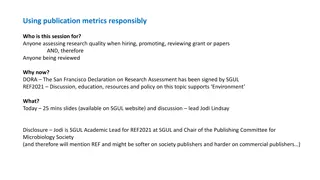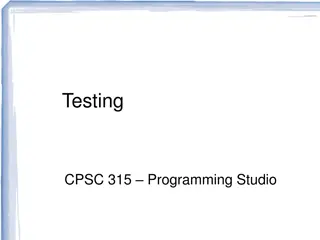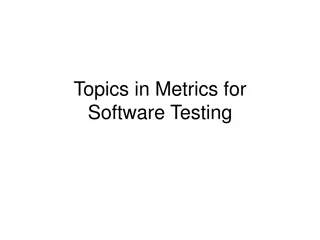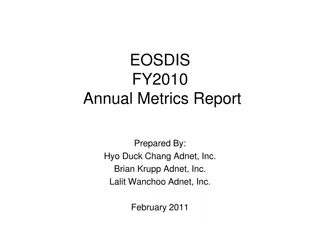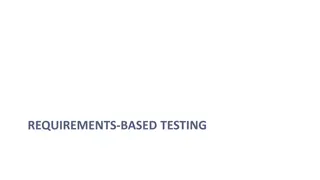Understanding Software Testing Metrics and Tools
Software testing metrics play a crucial role in evaluating the quality and progress of the testing process. Metrics provide valuable insights into the readiness, quality, and completeness of a product. By measuring attributes such as defects, testing efficiency, and productivity, organizations can make informed decisions to improve their testing processes. Testing tools aid in collecting and analyzing these metrics, enabling teams to enhance the effectiveness of their software testing initiatives.
Download Presentation

Please find below an Image/Link to download the presentation.
The content on the website is provided AS IS for your information and personal use only. It may not be sold, licensed, or shared on other websites without obtaining consent from the author. Download presentation by click this link. If you encounter any issues during the download, it is possible that the publisher has removed the file from their server.
E N D
Presentation Transcript
Testing Metrics and Tools SE401: Software Quality Assurance and Testing 1
Outline Testing Metrics Testing Tools Interview Questions 2
What is a Metric? Metrics can be defined as STANDARDS OF MEASUREMENT Metric is a unit used for describing or measuring an attribute Test metrics are the means by which the software quality can be measured Test metrics provides the visibility into the readiness of the product, and gives clear measurement of the quality and completeness of the product 3
Testing Metrics "We cannot improve what we cannot measure" and Test Metrics helps us to do exactly the same. Software Testing Metrics are the quantitative measures used to estimate the progress, quality, productivity and health of the software testing process. The goal of software testing metrics is to improve the efficiency and effectiveness in the software testing process and to help make better decisions for further testing process by providing reliable data about the testing process. 4
Testing Metrics Software testing metrics or software test measurement is the quantitative indication of extent, capacity, dimension, amount or size of some attribute of a process or product. Example for software test measurement: Total number of defects 5
Why we need Metrics ? You cannot Control what you cannot measure You cannot improve what you cannot measure Take decision for next phase of activities Evidence of the claim or prediction Understand the type of improvement required Take decision or process or technology change 6
Why Test Metrics The aim of collecting test metrics is to use the data for improving the test process. This includes finding answers to the questions like: How long will it take to test? How much money will it take to test? How bad are the bugs? How many bugs found were fixed? reopened? closed? deferred? How many bugs did the test team did not find? How much of the software was tested? Will testing be done on time? Can the software be shipped on time? How good were the tests? Are we using low-value test cases? What is the cost of testing? Was the test effort adequate? Could we have fit more testing in this release? 7
Types of Test Metrics Testing Metrics Process Metrics Product Metrics Project Metrics Process Metrics: used to improve the process efficiency of the SDLC ( Software Development Life Cycle) Product Metrics: deals with the quality of the software product Project Metrics: used to measure the efficiency of a project team or any testing tools being used by the team members 8
Identifying Metrics Identification of correct testing metrics is very important. Few things need to be considered before identifying the test metrics Fix the target audience for the metric preparation Define the goal for metrics Introduce all the relevant metrics based on project needs Analyze the cost benefits aspect of each metrics and the project lifestyle phase in which it results in the maximum output 9
Manual Test Metrics Manual test metrics are classified into two classes Base Metrics Calculated Metrics Manual Test Metrics Calculated Metrics Base Metrics 10
Manual Test Metrics Base metrics is the raw data collected by Test Analyst during the test case development and execution (# of test cases executed, # of test cases). Calculated metrics are derived from the data collected in base metrics. Calculated metrics is usually followed by the test manager for test reporting purpose (% Complete, % Test Coverage). 11
Testing Metrics Major Base Metrics: 1. Total number of test cases 2. Number of test cases passed 3. Number of test cases failed 4. Number of test cases blocked 5. Number of defects found 6. Number of defects accepted 7. 8. 9. 10. Number of planned test hours 11. Number of actual test hours 12. Number of bugs found after shipping Number of defects rejected Number of defects deferred Number of critical defects Base Metrics are a great starting point, and can then be used to produce calculated metrics 12
Testing Metrics Major Calculated Metrics: 1. Test Coverage Metrics: Test coverage metrics help answer, How much of the application was tested? . Two major coverage metrics: Test execution coverage Requirement coverage 13
Testing Metrics Major Calculated Metrics: 1. Test Coverage Metrics: test metrics - test execution coverage 1.1 This metric gives us an idea of the total tests executed compared to the total number of tests to be run. It is usually presented as a percentage value 14
Testing Metrics Major Calculated Metrics: 1. Test Coverage Metrics: test metrics - requirements coverage 1.2 This metric gives us an idea on the percentage of the requirements that have been covered in our testing compared to the total number of requirements 15
Testing Metrics Major Calculated Metrics: 2. Test Effectiveness Metrics: Test effectiveness answers, How good were the tests? or Are we running high value test cases? It is a measure of the bug-finding ability and quality of a test set. It can be calculated as follow: test metrics - effectiveness using defect containment efficiency 2.1 The higher the test effectiveness percentage, the better the test set is and the lesser the test case maintenance effort will be in the long-term. Example: If for a release the test effectiveness is 80%, it means that 20% of the defects got away from the test team. 16
Testing Metrics Major Calculated Metrics: 3. Test Effort Metrics: Test effort metrics will answer how long, how many, and how much questions about your test effort. These metrics are great to establish baselines for future test planning. Major Effort Metrics include: Number of test runs per time, number of defects per hour, number of bugs per test, and average time to test a bug fix. 17
Testing Metrics Major Calculated Metrics: 3. Test Effort Metrics: 3.1 This metric gives us an idea on the number of test runs over a certain period of time. (i.e. 30 tests per one day) 18
Testing Metrics Major Calculated Metrics: 3. Test Effort Metrics: 3.2 This metric provides information about the rate of finding defects by showing the number of detected defects per test hour. 19
Testing Metrics Major Calculated Metrics: 3. Test Effort Metrics: 3.3 This metric gives an estimation for the number of defects found in one test. This is calculated by dividing the total number of defects over the total number of conducted tests. 20
Testing Metrics Major Calculated Metrics: 3. Test Effort Metrics: 3.4 This metric presents the average time required to test a bug fix. Defect Time between fixing the defect and retesting the fix Example: Average time to test a defect fix= 4/3 = 1.3 defects per day D1 1 day D2 1 day D3 2 days Total 4 21
Testing Metrics Major Calculated Metrics: 4. Test Tracking and Quality Metrics: 4.1 This metric gives an indication on the quality of the tested application. It shows the percentage of passed test cases in relation to the total number of executed tests. 22
Testing Metrics Major Calculated Metrics: 4. Test Tracking and Quality Metrics: 4.2 This gives an indication on the quality of the tested application. It shows the percentage of failed test cases in relation to the total number of executed tests. It also gives an indication on the effectiveness of the conducted tests. 23
Testing Metrics Major Calculated Metrics: 4. Test Tracking and Quality Metrics: 4.3 This metric tracks the percentage of the critical defects in relations to the total number of reported defects. 24
Testing Metrics Major Calculated Metrics: 4. Test Tracking and Quality Metrics: 4.4 This metric calculates the percentage of the fixed defects in relations to the number of the reported defects. This also gives an indication on the efficiency of testing. 25
Testing Metrics Major Calculated Metrics: 5. Test Efficiency Metrics: 5.1 This metric calculates the average time taken to repair a defect by dividing the total time taken to fix all bugs over the total number of bugs. This metric gives an indication on how efficient repairing defects is. 26
Testing Metrics Major Calculated Metrics: More Metrics are used to monitor the testing team productivity, Cost of testing products, etc. You can read more about testing metrics in: https://www.qasymphony.com/blog/64-test-metrics/ https://softcrylic.com/blogs/top-25-metrics-measure-continuous-testing-process/ https://www.getzephyr.com/resources/whitepapers/qa-metrics-value-testing-metrics-within- software-development 27
Cumulative Test Time The total amount of time spent actually testing the product measured in test hours Provides an indication of product quality Is used in computing software reliability growth (the improvement in software reliability that results from correcting faults in the software) 28
Test Coverage Metrics Code Coverage (How much of the code is being exercised?) Requirements coverage (Are all the product s features being tested?) The percentage of requirements covered by at least one test 29
Quality Metrics Defect removal percentage What percentage of known defects is fixed at release? [Number of bugs fixed prior to release/ Number of known bugs prior to release] x 100 Defects reported in each baseline Can be used to help make decisions regarding process improvements, additional regression testing, and ultimate release of the software Defect detection efficiency How well are we performing testing? [Number of unique defects we find / (Number of unique defects we find + Number of unique defects reported by customers)] x 100 Can be used to help make decisions regarding release of the final product and the degree to which your testing is similar to actual customer use 30
Summary Fundamental test metrics are a combination of Base Metrics that can then be used to produce Calculated Metrics. Base Metrics raw collected data Calculated Metrics calculated from the base metrics 31
Summary Major Calculated Software Test Metrics Coverage Test Execution Coverage Requirement Coverage Effectiveness Effort Number of tests run per time Number of defects per hour Number of defects per test Average time to test a bug fix Quality Passed test cases Failed test cases Critical test cases Fixed Defect percentage Efficiency Major Base Software Test Metrics Total number of test cases Number of test cases passed Number of test cases failed Number of test cases blocked Number of defects found Number of defects accepted Number of defects rejected Number of defects deferred Number of critical defects Number of planned test hours Number of actual test hours Number of bugs found after shipping 32
Tool support for testing - types of tools Test tools can be used for one or more activities that support testing: Used directly in testing (e.g. test execution tools, test data generation tools, result comparison tools) Help in managing the testing process (e.g. test results, requirements, incidents, defects) and for monitoring and reporting the test execution Used in exploration (e.g. tools that monitor the file activity for an application) Any tool that aids in testing 35
Tool support for testing - purposes Tools can have one or more purposes, depending on the context: improve the efficiency of the test activities (e.g. by automating repetitive tasks) automate activities that require significant resources when done manually (e.g. static testing) automate activities that cannot be done manually (e.g. large scale performance testing of client server applications) increase reliability of testing (by automating large data comparisons or simulating complex behavior) 36
Testing Management Tools Characteristics Support for the management of tests and the testing activities Support for traceability of tests, test results and incidents to source documents, such as requirements specifications. Generation of progress reports Logging test results (Monitoring) Offer info on metrics related to the tests. 38
Testing Management Tools Test management tools and application lifecycle management tool (ALM) Requirements management tools Store requirements Check for consistency and undefined (missing) requirements Allow prioritization Requirements-Tests Traceability Defect management tools Configuration management tools Necessary to keep track of different versions and builds of SW and tests Useful when developing on more than one configuration of the HW/SW environment Continuous integrations tool 39
Static Testing Tools Tools for static testing Aid in improving the code/work product, without executing it Categories Review tools Supports the review process Static analysis tools Supports code examination Modeling tools Validate models of system/software 41
Static Testing Tools Review process tools Common reference for the review processes conducted Keep track of all the information from the review process Store and communicate review comments, report on defects and effort Monitoring review status --> Passed, passed with corrections, require re-review When to use? Suitable for more formal review processes Geographically dispersed teams 42
Static Testing Tools Static analysis tools Mostly used by developers --> Component (unit) testing Tool is executed --> Code is not The source code serves as input data to the tool Extension of compiler technology 43
Static Testing Tools Static analysis tools Supports developers and testers in finding defects before dynamic testing Purpose To better understand the code, and find ways of improving it Common features Calculate metrics --> Complexity, nesting levels --> identify areas of risk Enforce coding standards Analyze code structures and dependencies 44
Static Testing Tools SpotBugs look for bugs in Java code checks for more than 400 bug patterns 45
Static Testing Tools Static analysis tool example: Source Monitor Collects metrics from source code files Display and prints metrics in tables and charts 46
Static Testing Tools Static analysis tool example: Source Monitor 47
Static Testing Tools JDepend Generates design quality metrics for each Java package. Measure the quality of a design in terms of its extensibility, reusability, and maintainability. 48
Static Testing Tools Modeling tools Validate models of the system/software Purpose To better aid in designing the software Common features and characteristics Identify inconsistencies and defects within the models Identify and prioritize risk areas Predicting system response and behavior under various situations 49
Static Testing Tools Modeling tool example: StarUML UML tool Variety of diagrams Class/Domain Use case Sequence 50




